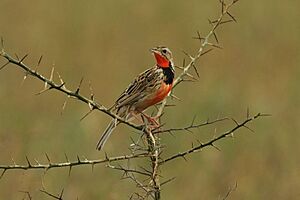Rosy-throated longclaw facts for kids
Quick facts for kids Rosy-throated longclaw |
|
|---|---|
 |
|
| In East Africa | |
| Conservation status | |
| Scientific classification | |
| Genus: |
Macronyx
|
| Species: |
ameliae
|
| Synonyms | |
|
Macronyx wintoni, Sharpe |
|
The rosy-throated longclaw, also called the rosy-breasted longclaw, is a beautiful bird known for its bright colors. Its scientific name is Macronyx ameliae. This bird belongs to the Motacillidae family, which includes wagtails and pipits. You can find rosy-throated longclaws in many countries across southern and eastern Africa. These include Angola, Botswana, Democratic Republic of the Congo, Kenya, Malawi, Mozambique, Namibia, South Africa, Tanzania, Zambia, and Zimbabwe. They love living in grasslands that are often wet or flooded, especially during certain seasons.
Contents
About the Rosy-Throated Longclaw
The rosy-throated longclaw was first described in 1845 by a French scientist named Marquis Léonce de Tarragon. He named the bird ameliae to honor either his wife or his mother, who were both named Amélie. Another scientist, Richard Bowdler Sharpe, later gave it the name M. wintoni in 1891, after William Edward de Winton. However, the name given by de Tarragon is the one used today.
Different Types of Rosy-Throated Longclaws
Scientists recognize three main types, or subspecies, of the rosy-throated longclaw. These types are found in different parts of Africa:
- M. ameliae ameliae: This type lives in Mozambique, Eswatini, and eastern South Africa.
- M. ameliae wintoni: You can find this type in southwestern Kenya and northern Tanzania.
- M. ameliae altanus: This type is spread across Botswana, Angola, Malawi, southwestern Tanzania, Zimbabwe, and Zambia.
What Does the Rosy-Throated Longclaw Look Like?
Adult rosy-throated longclaws are about 19 to 20 centimeters (about 7.5 to 8 inches) long. Their upper bodies are greyish-brown with a pattern that looks like scales.
Male and Female Birds
Male rosy-throated longclaws have a special pink throat and chest. This pink area has a wide black band across it, but you might only see this black band during the breeding season. Female birds also have pink underparts, but they do not have the black band. Young birds, called immatures, mostly have pale brown underparts with black streaks. They might have a little bit of pink-red color in the middle of their chest.
What Sound Do They Make?
The rosy-throated longclaw makes a sound that sounds like "chiteet." It's a call that reminds people of a pipit, which is another type of bird.
Where Do Rosy-Throated Longclaws Live?
These birds prefer wet grasslands and flood plains. They often live in areas with shorter grasses. While they are found across central and eastern Africa, their homes are more spread out in the southern parts of the continent. For example, in Botswana and Namibia, they mostly live in specific wet areas like the Okavango Delta, Linyanti Marshes, and Chobe floodplains. In Zimbabwe, they are found in the highveld, and in South Africa, they live in coastal areas of Kwazulu-Natal.
Threats to Their Home
In places like Kwazulu-Natal, the homes of rosy-throated longclaws are sometimes threatened by new buildings and developments along the coast.
Reproduction and Life Cycle
The rosy-throated longclaw breeds during the wet season. This usually happens from September to April. During this time, they lay eggs and raise their young.


